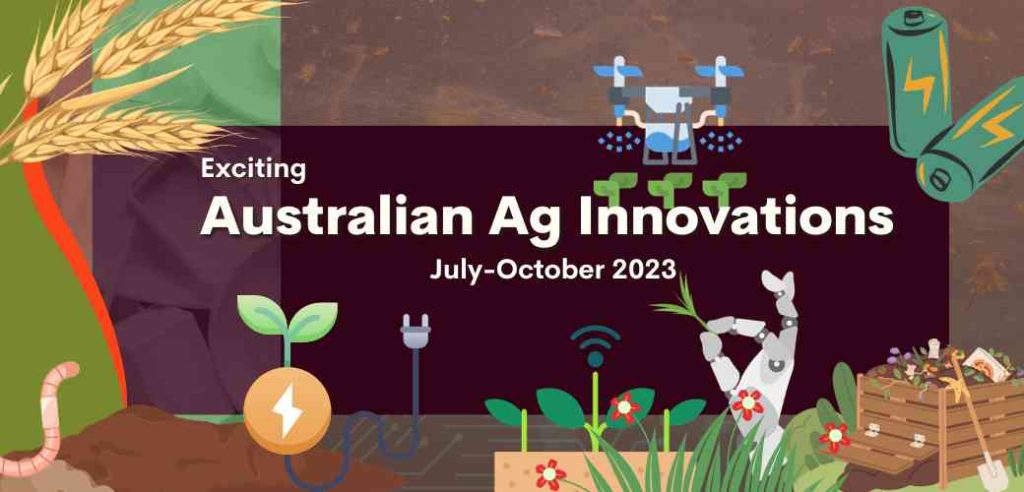Australia to the World: Innovations 2023

Australians are inventive, especially when it comes to the world of Agriculture. Our partners at AGCUMEN have compiled some of the latest innovations that will potentially revolutionise the industry in years to come. Everything from synthesised, sustainable fertiliser to long lasting, eco-friendly batteries.
Cracking the code for better barley – and more of it!
Researchers at the University of Adelaide have “for the first time” identified genes in barley that can “eventually lead to larger yielding crops.” The team used genetic techniques and molecular biology to examine historical multi-ovary barley mutants and discover the genes that boost fertility and allow the plants to be more receptive to cross-pollination. “Although the mutant varieties appeared to be quite similar when grown in the glasshouse, they found one type was more fertile than the others and was capable of producing up to three times the number of seeds than the other plants.” Compared to typical Australian barley varieties, the multi-ovary mutants can produce extra female reproductive organs in each flower. The sequences obtained from the mutant varieties can be used to “modify the flower structure of conventional barley, making it more receptive to hybrid breeding”, and by combining the mutant with other barley varieties, the researchers can “create stronger, more resilient crops that produce higher yields in even the most challenging of environments.” This breeding process is known as “hybrid vigour” and is already successfully being used in maize and rice. The findings are a “promising step” towards increasing grain yield through hybrid breeding in wheat and barley, and can pave the way for enhanced food security and a more sustainable agricultural future”- and to think, the researchers have barley even scratched the surface, read here.
Move over lithium-ion: Zinc-air batteries a cheaper and safer alternative
Recent research from Edith Cowan University (ECU) into the advancement of sustainable battery systems, has propelled zinc-air batteries ahead of the traditional lithium-ion batteries, as a better alternative for the electrical vehicle market and more. Studies have underlined how rechargeable zinc-air batteries (ZABs) are becoming more appealing due to their low cost, environmental friendliness, high theoretical energy density, and inherent safety. This goes hand-in-hand with new industry expectations, as there is an increasing need for safer, more cost-effective, and high-performance battery systems that can surpass the capabilities of lithium-ion batteries. While originally, ZABs struggled to meet core needs, with their major disadvantage being the limited power output, due to poor performance of air electrodes and short lifespan, engineers have combined them with new materials, such as carbon, cheaper iron and cobalt based minerals, successfully redesigning them to suppress the internal resistance and become more efficient. Now, these ZAB’s, that have the potential to thrive due to the abundance of zinc available in countries such as Australia, and the ubiquity of air, are becoming a highly viable and reliable energy storage solution, read more.
New sustainable way to synthesise vital fertiliser
Scientists from Queensland University of Technology (QUT) have discovered how to produce the vital agricultural fertiliser, urea, at room temperature without the large energy input of the traditional production process of synthetic urea. Urea is a nitrogen fertiliser for agriculture that supports 27% of world’s population’s crops. The team proposed a new solution for synthesizing urea using a chemical reaction between nitrogen and carbon monoxide with a graphene-based catalyst under room temperature and atmospheric pressure conditions. This approach significantly reduces energy inputs compared to traditional methods, making it a promising advancement in urea production. While this work is in the theoretical stage, the researchers have identified a promising catalyst for sustainable, energy efficient urea synthesis. The team is now collaborating with other research groups to move towards practical application of this new technology, read more.
Smaller, lighter lithium-sulphur battery lowers costs and improves recycling options
Researchers at Monash University and RMIT University have developed a new lithium-sulphur battery design with a nanoporous polymer-coated lithium foil anode that reduces the amount of lithium required in a single battery. In their recent paper the researchers outline how applying the nanoporous polymer directly onto the lithium foil anode has created a new battery design that uses less lithium, has more energy per unit volume, lasts longer and will be half the price of lithium-ion batteries. Lithium-sulphur (Li-S) batteries are an emerging energy storage technology that utilise metallic lithium and sulphur to deliver more energy per gram than lithium ion batteries. While the Li-S batteries are highly efficient, the process of finding, extracting and transporting lithium leaves a significant environmental footprint, so using as little lithium as possible remains important. Li-S batteries also have their limitations. The new thin polymer coating on lithium significantly improved the number of times the battery could be cycle. The new design does not require nickel or cobalt, which removes the need for minerals that have a significant environmental and social cost, read more.
New cyber algorithm shuts down malicious robotic attack
Australian researchers have designed an algorithm that can intercept a man-in-the-middle (MitM) cyberattack on an unmanned military robot and shut it down in seconds. In an experiment using deep learning neural networks to simulate the behaviour of the human brain, AI experts from Charles Sturt University and University of South Australia trained the robot’s operating system to learn the signature of a MitM eavesdropping cyberattack. This is where attackers interrupt an existing conversation or data transfer. The algorithm, tested in real time on a replica of a United States army combat ground vehicle, was 99% successful in preventing a malicious attack. False positive rates of less than 2% validated the system, demonstrating its effectiveness, read more.
Turning mine waste into healthy soil
Tailings, the waste left after extracting precious and critical minerals, often contain harmful chemicals and heavy metals that can pollute soil, water and even crops. There are over 1800 tailings storage facilities around the world. The tailings dam collapse in Brazil in 2019 killed almost 300 people while also polluting local land and waterways. Now a team led by researchers at the University of Queensland has developed an innovative method to turn harmful tailings into healthy soil. The scientists used the Canadian Light Source (CLS) at the University of Saskatchewan to determine the underlying mechanism of their process. Tailings have no biologically friendly properties for growing plants. Roots and water cannot penetrate them, and soluble salts and metals in tailings can kill plants and soil microbes. Nature can turn tailings into soil but it could take a couple thousand years. The researchers found a way to accelerate natural soil formation processes to convert tailings into healthy soil. The process involves encouraging specific microbes to grow in tailings that have been amended with plant mulch from agricultural waste and urban green waste. These microbes “eat” the organics and minerals in tailings, transforming them into functional aggregates (or soil crumbs), the building blocks of healthy soil, read more.
‘Radical’ new green power source
Scientists from Flinders University in South Australia and Zhejiang Sci-Tech University in China are hoping to make the world’s first safe and efficient non-toxic aqueous aluminium radical battery after they have reported the first stage of the development of such novel batteries. The scientists collaborated on the (electro-) chemistry of stable radicals in the most-used Lewis acid electrolyte (Al(Otf)3 and battery test. They developed the first design of aluminium radical batteries, which use water-based electrolytes that are fire-retardant and air-stable, delivering a stable voltage output of 1.25 V and a capacity of 110 mAh g–1 over 800 cycles with only 0.028% loss per cycle. The researchers aim to use biodegradable materials for development of the soft-pack batteries in the future to make the product safe and sustainable, read more.
